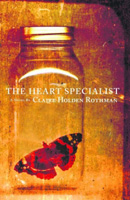

Cormorant Books, paperback, 9781897151211
I raced through this novel at one sitting (it's a missing-your-bus-stop kind of a read) and then went back to re-read more slowly. Claire Holden Rothman, inspired by the life of Dr Maud Abbott (1869-1940), one of Montreal's first female doctors, loosely based this engrossing story on Abbott's experiences.
The novel's heroine is Agnes White, who is intelligent (certainly too clever to easily get a husband), feisty and determined to become a doctor. This is at a time when it was still rare for a woman to get into medical school. In fact McGill, her father's alma mater, still refused to allow females to study medicine. I wanted to scream in frustration at the reasons male doctors used to give for keeping women out of the profession.
Throughout her life Agnes has been haunted by a family mystery. Her father, a doctor, had been charged with the murder of his invalid sister, though he was later acquitted. The scandal caused her father to abscond when Agnes was only five. She intends to find him again one day. Meanwhile she uses his old microscope and tries to teach herself anatomy by dissecting small animals in an old barn. Not surprisingly this doesn't go down too well with Agnes' grandmother.
The sense of time and place in The Heart Specialist is convincing, and Agnes' struggles are well portrayed. I really sympathised with the fight the female students had to be taken seriously by the male medics. The detailed medical descriptions demonstrate the author's research, which was very well used. I could picture the musty museum exhibits and the old barn with the hidden microscope very clearly. The descriptions of hearts preserved in jars were fascinating; I was almost (but not quite!) convinced of the beauty of these specimens.
Agnes White's story is told chronologically in dated chapters. At times the author jumps over many years, which can be frustrating; while reading, I desperately wanted to know what had happened to Agnes, say, in the gap of ten years or so that had just been skated over. The characters were extremely well drawn. I loved the contrast painted between Agnes and Kitty Howlett, Dr Howlett's beautiful society wife. In one memorable scene Kitty is serving an elegantly prepared meal, in an equally elegant gown while poor Agnes' outfit is shabby and travel stained. And she has a bag under the table with a diseased heart in it: a disaster waiting to happen….
Although Agnes forms a lifelong friendship with Miss Skerry, her childhood governess, generally she thinks women are rather silly. Her strongest bonds are with the men with whom she works. Dr William Howlett, her father's colleague and friend has a profound impact on her professional (and emotional life). She struggles to reconcile her ambitions with her personal life, and it takes her a long time to realise how close she is to personal happiness.
A lovely thread running through the novel is the superstition of St Agnes Eve, January 20th, when a girl
is supposed to dream of the man she will marry. It is the custom in her family to read Keats' "The Eve of
Saint Agnes" on Agnes' name day. (As I imagined the characters reciting Keats I was reminded of Harry
Clarke's beautiful stained glass windows in Dublin that depict the tale of St Agnes in gorgeous colours.) And
does Agnes White dream of her future husband? Well, I'll leave it to you to find out.
